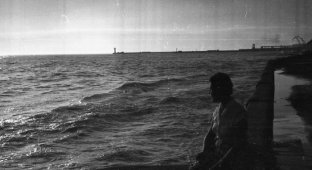Author's project by Andrey Shapran.
These are always the northern territories of the Russian Federation - closed to visitors and classified during the Soviet period. Now they are no less difficult to access, although for other reasons - purely technical. A four-month trip to Chukotka in 2015 became the next stage in my project.
Northern Cape - this name was given to the territory by James Cook personally, who drifted here in 1778. This was the northernmost point of the mainland he reached. In Russia at that time Catherine II was on the throne, and these lands only appeared on the maps from a blank spot.
And in these places the blizzard howls continuously for weeks and there are no other sounds in the entire area
A monument on the coast at the entrance to the village of Schmidt on the western side, in memory of the sailors who remained at sea.

Cape Weber is the name of part of the Northern Cape. Another day or two and the sea will disappear under the ice.

Abandoned ship on the coast.

In Soviet times, the Northern Cape was one of the most closed places on earth: military units, an air defense base were located here, and military aircraft were received and dispatched here. This was called the “jump airfield” for strategic aviation when it flew to bomb America.
Today this land is almost completely free from the presence of people - the population of the cape has decreased from 17,000 to three dozen people; the local village of Cape Schmidt was officially resettled in 2013. The military is gradually beginning to return to the airfield area, but from the deserted village this is practically unnoticeable.
Monument to Otto Yulievich Schmidt at the entrance to the village of Schmidt from the airfield.

The closed Polyus Hotel on the territory of the closed airport at Cape Schmidt.

Cape Schmidt, snowstorm. Decommissioned planes at the runway.

The strongest snowstorm occurred here in late autumn - early winter of 2015. The weather, even for these places, was simply catastrophic.
Locals never say "blizzard". This is too weak a word, “from the mainland.” They say “blizzard”.
Andrey Shapran:
“Before my eyes, in a few days, the snowdrifts rose to a height of up to two meters. The landscape was transformed from a harsh painting into graphics.
I went to the same place ten times - Cape Weber and Cape Schmidt (they together make up the Northern Cape). Every day everything changed there, continuously, hour after hour."
The village of Shmidt overlooking the East Siberian Sea.

Abandoned remains of radar installations. Panorama of Cape Weber with a view of the Chukotka national village of Ryrkaipiy.

An abandoned fortification at the entrance to the airfield from the eastern side.

The area of military fortifications on the eastern side of Cape Schmidt.

Eastern side of the village of Shmidt.

A shot-through star on a children’s grave (it’s very old, dating back to 1943) on the territory of an abandoned military air defense base

Blizzard on the Northern Cape.

Blizzard on the Northern Cape.

Remains of a fence at an abandoned air defense base.

Wave on the coast. Cape Schmidt.

On the coast. Cape Schmidt.

At an abandoned air defense base.

Cape Kozhevnikov and the East Siberian Sea, covered with slush.

East Siberian Sea, last tide on the coast in the Schmidt area. In a few hours, the surf will “stop” here, everything will be filled with slush - fine, loose ice that appears before the freeze-up.

The territory of former military warehouses in the Schmidt area.

On the abandoned territory of an air defense base.

On the territory of the “new” cemetery.
Several years ago, local residents made an unsuccessful attempt to ward off polar bears from their settlement - they took several dozen walrus carcasses to the hills. Polar bears did not leave the coast for bait, but brown bears came from the tundra; they are considered even more aggressive. The bears ate the corpses of walruses and the next year they took up human remains in the local cemetery - they tore up graves, chewed wooden coffins... Local hunters began to shoot them, there were fewer animals, but bear vandalism did not stop completely... Now they are buried in a new cemetery, and coffins with bodies are placed in metal containers.

On the territory of the “new” cemetery.

The IL-14 monument on the abandoned GMO territory was erected by a local enthusiast, air traffic controller of the Shmidtov airport Yuri Dunaev, on the third attempt - in honor of the legendary aircraft that took part in the development of the Far North.

The former territory of the air defense base on the territory of the Northern Cape.

Blizzard on the coast.

An abandoned ship wreck covered with layers of ice.

Abandoned ship on the coast. Blizzard.

Urban settlement Cape Schmidt (or simply Schmidt, as the locals say).

Urban settlement Cape Shmidt.

Panorama of the closest still populated area - the national village of Ryrkaipiy from the coastline of the East Siberian Sea. Population - 600 people. The name of the village is translated from the Chukchi language as “congestion for walruses.”

A little history
August 1778.
The cape was first described by the English explorer James Cook and named him North Cape (“northern cape”), as it was the northernmost point he reached. The name applied to the entire territory from the present Cape Kozhevnikov to Cape Schmidt. Local residents still often call all these places the Northern Cape.
1934
The area of the village and the surrounding area were named in honor of the outstanding Soviet polar explorer Otto Schmidt.
1962
The settlement on the cape receives the status of an urban-type settlement.
1973
The village of Cape Shmidt becomes the administrative center of the Shmidtovsky district. Local industrial enterprises and a hydrometeorological station operate here. Military units are deployed. The population reaches 17,000 people.
2008
The Shmidtovsky district was abolished as an administrative unit.
year 2013.
The authorities of the Chukotka Autonomous Okrug made a decision to organize the resettlement of the village residents to other, more favorable places of residence. This was due to the serious deterioration of the housing stock and social infrastructure and the high costs of their maintenance, and most importantly, to the lack of prospects for the development of the village.
year 2014.
Plans have been announced to restore the military infrastructure of the Cape Schmidt airfield. More than 1.5 billion rubles have been allocated for infrastructure development work. In October 2014, units of the Eastern Military District began combat training duty to protect the air borders of the Russian Federation at Cape Schmidt. In November of the same year, a modular residential block for military personnel was put into operation.
July 2015.
Spetsstroy of Russia announced plans to fully equip a military camp and airfield infrastructure at Cape Schmidt by the end of the year, which will be used by the Joint Strategic Command “North” created on December 1, 2014.
P.S. Are you still complaining about winter?






















